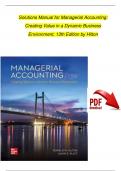Examen
Solutions Manual For Managerial Accounting: Creating Value in a Dynamic Business Environment, 13th Edition by Ronald W. Hilton, David E. Platt, All Chapters 1 - 17, Complete Newest Version
- Cours
- Établissement
- Book
Solutions Manual for Managerial Accounting: Creating Value in a Dynamic Business Environment, 13th Edition by Ronald W. Hilton, David E. Platt, All Chapters 1 - 17, Complete Newest Version Solutions Manual for Managerial Accounting: Creating Value in a Dynamic Business Environment, 13th Edition ...
[Montrer plus]




